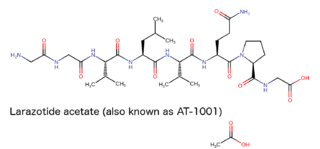Larazotide acetate
Larazotide acetate (also known as AT-1001) is a synthetic eight amino acid peptide that functions as a tight junction regulator and reverses leaky junctions to their normally closed state. It is being studied in people with celiac disease.
Note that another drug candidate exists with the designation AT-1001 (N-(2-bromophenyl)-9-methyl-9-azabicyclo[3.3.1] nonan-3-amine) which is a ligand of α3β4 nicotinic receptors that may decrease nicotine craving.[1]
Structure

Larazotide acetate has the amino acid sequence GGVLVQPG, a IUPAC Condensed descriptor of H-Gly-Gly-Val-Leu-Val-Gln-Pro-Gly-OH.CH3CO2H, a systematic name glycine, glycylglycyl-L-valyl-L-leucyl-L-valyl-L-glutaminyl-L-prolyl-, monoacetate and an average molecular mass of 725.8 Daltons.[2][3]
Mechanism of action
In celiac disease, one pathway that allows fragments of gliadin protein to get past the intestinal epithelium and subsequently trigger an immune response begins with binding of indigestible gliadin fragments to the chemokine CXC motif receptor 3 (CXCR3) on the luminal side of the intestinal epithelium (see this page). This leads to the induction of myeloid differentiation factor 88 (MYD88) and the release of zonulin into the lumen. Zonulin then binds to epidermal growth factor receptor (EGFR) and protease-activated receptor 2 (PAR2) in the intestinal epithelium. This complex then initiates a signalling pathway that eventually results in tight junction disassembly and increased intestinal permeability. Larazotide acetate intervenes in the middle of this pathway by blocking zonulin receptors, thereby preventing tight junction disassembly and associated increase in intestinal permeability.[4][5]
Origin
Larazotide acetate is a synthetic peptide based on a Vibrio cholerae enterotoxin called zonula occludens toxin that increases intestinal permeability. An investigation was carried out to discover which specific part of this toxin was responsible for this activity. Several mutants were constructed and tested for their biological activity and their ability to bind to intestinal epithelial cells in culture. The responsible region was located near the carboxyl terminus of the toxin protein. This region coincided with a peptide product generated by Vibrio cholerae. The eight amino acid sequence in this region was shared with zonulin, an endogenous protein involved in tight junction modulation. This sequence was later designated larazotide acetate.[6]
References
- ↑ Cippitelli, Andrea; Wu, Jinhua; Gaiolini, Kelly A; Mercatelli, Daniela; Schoch, Jennifer; Gorman, Michelle; Ramirez, Alejandra; Ciccocioppo, Roberto; Khroyan, Taline V (2015-04-01). "AT–1001: a high-affinity α3β4 nAChR ligand with novel nicotine-suppressive pharmacology". British Journal of Pharmacology. 172 (7): 1834–1845. doi:10.1111/bph.13034. ISSN 0007-1188. PMC 4376460
 . PMID 25440006.
. PMID 25440006. - ↑ Pubchem. "Larazotide acetate | C34H59N9O12 - PubChem". pubchem.ncbi.nlm.nih.gov. Retrieved 2016-04-16.
- ↑ "ChemIDplus - a TOXNET database". Retrieved 16 April 2016.
- ↑ Fasano, Alessio (2011-01-01). "Zonulin and Its Regulation of Intestinal Barrier Function: The Biological Door to Inflammation, Autoimmunity, and Cancer". Physiological Reviews. 91 (1): 151–175. doi:10.1152/physrev.00003.2008. ISSN 0031-9333. PMID 21248165.
- ↑ Khaleghi, Shahryar; Ju, Josephine M.; Lamba, Abhinav; Murray, Joseph A. (2016-01-01). "The potential utility of tight junction regulation in celiac disease: focus on larazotide acetate". Therapeutic Advances in Gastroenterology. 9 (1): 37–49. doi:10.1177/1756283X15616576. ISSN 1756-283X. PMC 4699279
 . PMID 26770266.
. PMID 26770266. - ↑ Di Pierro, M.; Lu, R.; Uzzau, S.; Wang, W.; Margaretten, K.; Pazzani, C.; Maimone, F.; Fasano, A. (2001-06-01). "Zonula occludens toxin structure-function analysis. Identification of the fragment biologically active on tight junctions and of the zonulin receptor binding domain". The Journal of Biological Chemistry. 276 (22): 19160–19165. doi:10.1074/jbc.M009674200. ISSN 0021-9258. PMID 11278543.